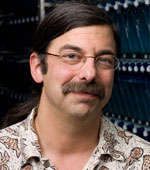David J. Grunwald
E-mail:
Education:
B.A. 1975, Williams College; Ph.D. 1981, University of Wisconsin
RESEARCH:
Tissue specification and disease modeling in the zebrafish
We want to understand regulation of cell identity and differentiation in the early vertebrate embryo. We work with zebrafish because of the precision with which tissue development can be monitored in the nearly transparent, rapidly developing zebrafish embryo, and the ease with which gene expression can be perturbed and mutants can be isolated. Three major projects in the lab are aimed at understanding: 1) the role of intracellular calcium mobilization in tissue patterning events, 2) factors that confer identity to the stem cell-like precursors of the neural crest, and 3) how the mesoderm germ layer is subdivided into groups of tissue precursors that occupy specific regions of the embryo.
The current studies of calcium mobilization began with our search for a conceptual framework for thinking about the origin of a series of congenital myopathies. Like many birth defects, congenital muscle diseases are often first recognized and characterized at times far removed from the onset of the disorder, making it difficult to identify the initial biochemical or cellular defects that trigger the disease process. Our studies of zebrafish embryos and diseased tissue have shown that different genetic disorders associated with congenital myopathies directly disrupt mobilization of intracellular calcium.
Our work indicates intracellular calcium release is required to orchestrate tissue patterning in many contexts and is required specifically for cell differentiation events that require transmission of Hedgehog growth factor signaling. In ongoing studies, we are analyzing the roles of calcium mobilization in mediating many kinds of intercellular signaling events, including those required for neuronal patterning, muscle differentiation, and left-right patterning. In addition, we are investigating the mechanisms by which calcium release is regulated, including the roles of Selenoproteins in regulating calcium release channel activity.
A second project is aimed at uncovering the genetic program that leads to formation of the neural crest. We identified a mutation that blocks formation of the neural crest, and found the mutant gene encodes PAF-1, a component of a transcription regulatory complex required in many types of stem cells. Current work focuses on identifying the molecular function of PAF-1 and the downstream genes whose expression is needed for neural crest identity.
A third project is to understand how groups of T-box genes, which encode related transcription factors, coordinate development of multiple neighboring tissues. T-box gene mutations cause congenital defects of the heart, limb, and other organ systems. Each syndrome appears to be composed of multiple cellular defects, as if the relevant T-box gene has different functions in different cell types. To explain this recurrent phenomenon, we proposed that individual T-box transcription factors indeed have different functions in different cells because the target genes regulated by any individual factor are determined by the combination of T-box transcription factors co-expressed in a cell. Our work aims to identify the primary cellular and molecular targets of T-box transcription factors and to understand how combinations of T-box factors interact to assign cell identity.
Selected Publications:
Jurynec, M.J. and Grunwald, D.J. (2010) SHIP2 modulates FGF signaling in the establishment of the dorsoventral axis in zebrafish. Disease Models and Mechanisms, 3:xxx-xxx.
Bai, X., Kim, J., Yang, Z., Jurynec, M.J., Lee, J., LeBlanc, J., Sessa, A., Akie, T.E., Jiang, H., Grunwald, D.J., Lin, S., Cantor, A.B., Orkin, S.H. and Zon, L.I. (2010) TIFγ controls erythroid cell fate by regulating transcription elongation. Cell, 142:133-143.
Jurynec, M.J., et al. (2008) Selenoprotein N is required for Ryanodine Receptor calcium release channel activity in human and zebrafish muscle. Proc Natl Acad Sci USA, 105:12485-12490.
Lamason, R.L., et al. (2005) SLC24A5, a putative cation exchanger, affects pigmentation in zebrafish and man. Science, 310:1782-1786.
Goering, L. M., Hoshijima, K., Hug, B., Bisgrove, B. W., Kispert, A., and Grunwald, D. J. (2003) An interacting network of T-box genes directs gene expression and fate in the zebrafish mesoderm. Proceedings National Academy of Sciences (USA), 100:9410-9415.
Grunwald, D. J., and Eisen, J. S. (2002) Headwaters of the zebrafish - emergence of a new model vertebrate. Nature Reviews Genetics 3:717-724.
Hoshijima, K., Metherall, J. E., and Grunwald, D. J. (2002) A protein disulfide isomerase expressed in the embryonic midline is required for left/right asymmetries. Genes & Development 16:2518-2529.
Korzh, V., and Grunwald, D. J. (2001) Nadine Dobrovolskaia-Zavadskaia and the dawn of developmental genetics. Bioessays 23:365-371.
Appel, B., Fritz, A., Westerfield, M., Grunwald, D. J., Eisen, J., and Riley, B. B. (1999) Delta-mediated specification of midline cell fates in zebrafish embryos. Curr. Biol. 9:247-256.
Cretekos, C. J., and Grunwald, D. J. (1999) alyron, an insertional mutation affecting early neural crest development in zebrafish. Develop. Biol. 210:322-338.
Dorsky, R. I., Snyder, A., Cretekos, C. J., Grunwald, D. J., Geisler, R., Haffter, P., Moon, R. T., and Raible, D. W. (1999) Maternal and embryonic expression of zebrafish lef1. Mech. of Develop. 86:147-150.
Hug, Walter, and Grunwald. (1997) tbx6, a Brachyury-related gene expressed by ventral mesendodermal precursors in the zebrafish embryo. Developmental Biology 183:61-73.
Riley, B. R., and Grunwald, D. J. (1995) Efficient induction of point mutations allowing recovery of specific locus mutations in zebrafish. PNAS 92: 5997-6001.
Helde, K. A., Wilson, E. T., Cretekos, C. J., and Grunwald, D. J. (1994) Contribution of early cells to the fate map of the zebrafish gastrula. Science 265: 517-520.

